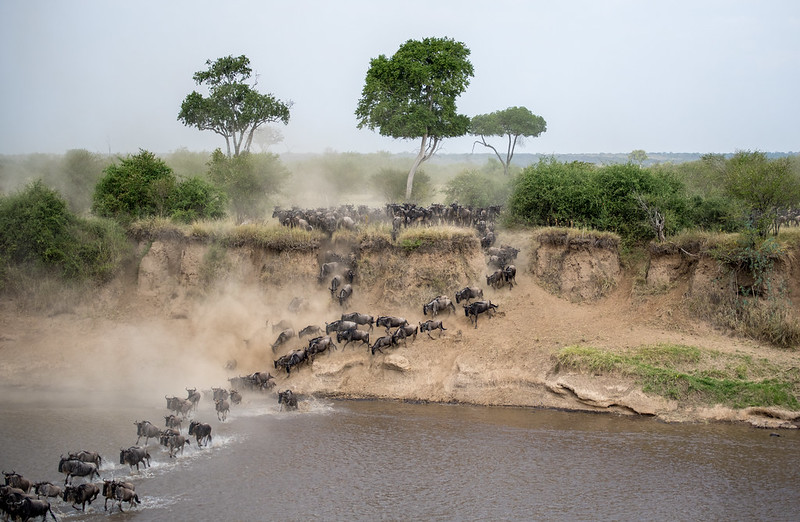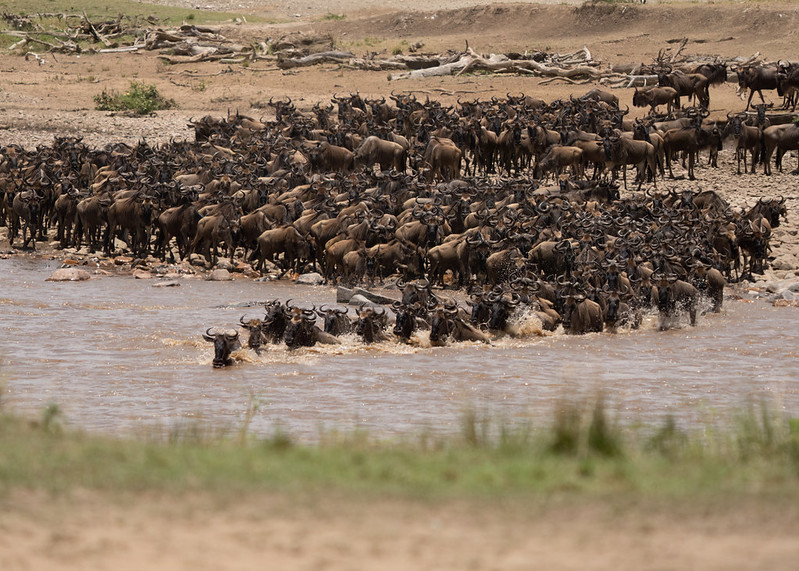The Wildebeests start arriving Kenya in June and by July- August, the entire plains of Mara have been occupied by the wildebeests, zebras and gazelles and its when mara crossing is in progress
Masai Mara National Reserve In Kenya
Overview
Masai mara national reserve also referred as the mara is Keya’s prime destination one also one of the most popular safari parks in the world.
The Maasai Mara National Reserve is a renowned wildlife reserve located in southwestern Kenya, adjacent to the Tanzanian border. It’s part of the larger Serengeti ecosystem and is well-known for its diverse and abundant wildlife, particularly during the annual wildebeest migration.
The Maasai Mara is home to a wide variety of wildlife, including the “Big Five” (lion, elephant, buffalo, leopard, and rhinoceros), wildebeest, zebra, giraffe, cheetah, hyenas, and many other species of animals.
The Maasai Mara is famous for the annual Great Migration, where millions of wildebeest, zebras, and gazelles migrate from the Serengeti in Tanzania to the Maasai Mara in Kenya in search of greener pastures. This natural phenomenon usually occurs between July and October.
The reserve is characterized by vast grasslands, acacia woodlands, and the Mara River, which plays a crucial role in the Great Migration. The diverse landscape provides a range of habitats for different wildlife species.
Maasai Mara is also a haven for birdwatchers, with over 450 bird species recorded, including eagles, vultures, ostriches, and various species of storks, among others.
The Maasai people, a semi-nomadic ethnic group, inhabit the region and have a rich cultural heritage. Many lodges and tour operators offer cultural visits to Maasai villages, providing visitors with an opportunity to learn about their traditions, lifestyle, and crafts.
Conservation is a significant focus in the Maasai Mara, with efforts to protect the delicate ecosystem and its wildlife. Conservation organizations and local communities work together to ensure sustainable tourism and wildlife management.
The Maasai Mara is a major tourist destination in Kenya, attracting visitors from around the world. It offers a range of accommodations, including luxury lodges, tented camps, and budget-friendly options. Tourists visiting the Maasai Mara National Reserve can enjoy game drives, hot air balloon safaris, guided nature walks, and cultural experiences, all while being immersed in the breathtaking African wilderness and its wildlife.
The reserve derived its name Mara from the Masai word to meaning ‘’spotted” due to the short plain grass and rolling hills.
The Masai is crossed by the Mara and Telek rivers which offer spectacular sightings during the famous Great Migration. The great migration involves movement of millions of animals including Zebras, Wildebeests, antelopes, gazelles from the plains of the Serengeti in to Masai mara.

Related Kenya Safaris
Attractions In This National Park
Animals/ wildlife and birds of Masai Mara National Reserve: The Masai mara has got variety of mammal species ranging from the big five game, several bird species to different plan species. During the game drives in the park, you will encounter several mammal species around the plains with almost all the national parks seen in the park.
The mara reserve is famous for the big five animals including (lions, Leopards, Elephants, Buffalos except for the Rhinos which are only black species found. The big five are hard to miss in Masai mara among other variety of mammal species.
The Maasai Mara National Reserve, located in Kenya, is renowned for its diverse and abundant wildlife. Below are some of the animals, wildlife, and birds you might encounter in the Maasai Mara:
Big Cats:
Lions: Maasai Mara is known for its lion population, and it’s common to spot prides of lions resting or hunting.
Leopards: These elusive big cats are also present, often seen in the trees or stalking their prey.
Cheetahs: Maasai Mara is one of the best places to witness cheetahs in action, showcasing their incredible speed.
Herbivores:
Elephants: Both African bush elephants and forest elephants can be found in the reserve.
Zebras: The Mara is home to large herds of zebras, known for their distinctive black and white stripes.
Wildebeests: During the Great Migration, massive herds of wildebeests migrate through the Mara.
Giraffes: Both Masai and Rothschild’s giraffes are commonly seen.
Buffaloes: African buffaloes are often spotted in groups, particularly near watering holes.
Antelopes: Thompson’s gazelles, impalas, Grant’s gazelles, topis, and elands are common antelope species in the Maasai Mara.
Birds: Secretary bird: Known for its distinctive appearance with long legs and quills on its head.
African fish eagle: Recognizable by its white head and tail, and yellow beak.
Martial eagle: A large and powerful eagle often seen in the Mara.
Lilac-breasted roller: A beautiful bird known for its striking colors.
Crowned crane: Characterized by its distinctive crown-like tuft of feathers on its head.
Other Wildlife:
Hippos: Found in the Mara River and other water bodies within the reserve.
Crocodiles: Commonly seen in the Mara River, especially during the Great Migration when wildebeests and zebras attempt river crossings.
Other Predators:
Spotted hyenas: Often seen scavenging or hunting in the Mara.
Jackals: Both black-backed and side-striped jackals can be spotted.
The Maasai Mara is famous for its annual wildebeest migration, where massive herds of wildebeests and zebras migrate between the Maasai Mara in Kenya and the Serengeti National Park in Tanzania in search of greener pastures. This migration typically occurs between July and October. It’s a spectacle that attracts tourists from around the world.

Activities In This National Park
Things to see and do in Masai mara Kenya: The Maasai Mara National Reserve in Kenya is renowned for its incredible wildlife and stunning landscapes, making it a popular destination for tourists seeking a safari experience. Here are some things to see and do in the Maasai Mara:
Wildlife Safari:
Explore the Maasai Mara’s vast savannahs and witness the rich wildlife that inhabits the reserve. Spot the “Big Five” (lion, elephant, buffalo, leopard, and rhinoceros), cheetahs, wildebeests, zebras, giraffes, and an array of antelopes.
Great Migration:
If visiting between July and October, you can witness the Great Migration, one of the most awe-inspiring natural events, where millions of wildebeest, zebras, and gazelles migrate from Tanzania’s Serengeti National Park to Maasai Mara.
Hot Air Balloon Safari:
Take an unforgettable hot air balloon ride over the Maasai Mara at dawn to see the wildlife from a unique vantage point and experience the breathtaking views of the reserve.
Nature Walks and Guided Hikes:
Join a guided walking safari to explore the flora, fauna, and smaller creatures that you might miss during a traditional safari. This is a great way to appreciate the finer details of the ecosystem.
Cultural Visits to Maasai Villages:
Immerse yourself in the Maasai culture by visiting a local Maasai village, where you can interact with the Maasai people, learn about their traditional lifestyle, dances, crafts, and rituals.
Photography and Bird Watching:
The Maasai Mara offers exceptional opportunities for photographers and bird watchers. Capture stunning shots of wildlife and the diverse bird species found in the region.
Hippo and Crocodile Watching:
Visit the Mara River and its tributaries to observe hippos and crocodiles, particularly during the migration when the river crossings are an intense and dramatic sight.
Balloon Safaris:
Experience a sunrise or sunset balloon safari over the Maasai Mara, providing a unique aerial perspective of the reserve and its inhabitants.
Conservancy Visits:
Explore the private conservancies adjacent to the Maasai Mara, which often offer a more exclusive and intimate safari experience with fewer crowds.
Camping and Lodges:
Stay at a safari lodge, luxury tented camp, or go camping in designated sites within the reserve. This allows you to fully immerse yourself in the natural surroundings and wildlife.
Cultural Events and Festivals:
Check if there are any local events or festivals happening during your visit, such as traditional dances, ceremonies, or community gatherings, to further enrich your cultural experience.
Hot Springs and Waterfalls:
If time allows, venture to nearby hot springs or waterfalls, such as the Sekenani and Olkoroi waterfalls, to witness the beauty of Maasai Mara beyond its wildlife.
Remember to prioritize responsible and sustainable tourism to protect the natural habitat and support the local communities in the Maasai Mara.
Best Time To Visit
- Best time to visit Masai mara National Reserve: The reserve is a year-round destination with something to offer in every season, but there are a few key factors to consider.
The biggest number of travelers visit Masai mara during the migration time between July and October. During this period, millions of wildebeest, zebras, and other herbivores migrate from Tanzania’s Serengeti National Park to the Masai Mara in search of fresh grazing lands. This is a truly spectacular event and attracts visitors from around the world.
The migration time is when there are most tourists visiting the Masai mara reserve and also expect lots of safari cars in the reserve during the game drives. - Wildlife Viewing: For general wildlife viewing, the dry season from June to October is excellent. The vegetation is less dense, and animals gather around watering holes and rivers, making them easier to spot. The weather is also drier during this time, reducing the risk of rain disrupting your game drives.
After the migration when the herds have gone back, Masai mara is relatively calm and quite with fewer tourists in the park. But still plenty of game. For the visitors having no interest in the migration and bigger crowds, then you can visit Masai mara form November with many game species including Elephants and buffalos are in plenty when the migration has left. The elephants are irritated by the constant groaning of the wildebeests and are forced to move higher up into the hills to have their peace. Lions and other cats tend to be better seen when the migration has left because they are forced to move more to hunt the less available prey left in the Mara.
How to get there
How to get to Masai mara reserve: Maasai Mara National Reserve, which is located in southwestern Kenya, you’ll typically need to go through Nairobi, the capital city of Kenya. Here’s a step-by-step guide to help you plan your trip:
Fly to Nairobi, Kenya:
If you’re traveling internationally, book a flight to Jomo Kenyatta International Airport (NBO) in Nairobi, Kenya.
Nairobi to Maasai Mara by Air:
The most convenient way to reach Maasai Mara from Nairobi is by taking a domestic flight. Several airlines offer flights from Nairobi to nearby airstrips like Keekorok Airstrip, Olkiombo Airstrip, or Mara Serena Airstrip in Maasai Mara. The flight takes approximately 45 minutes to 1 hour.
Nairobi to Maasai Mara by Road:
If you prefer ground transportation, you can hire a private vehicle, take a shuttle, or use a tour company to drive from Nairobi to Maasai Mara. The road trip takes around 5-6 hours, depending on the route and traffic.
Self-Driving:
Renting a car and driving to Maasai Mara is an option if you’re comfortable with driving in Kenya. The most common route is via Narok town.
Tour Companies and Shuttles:
Many tour companies and shuttle services operate between Nairobi and Maasai Mara, offering various packages and options to suit your preferences.
Public Transport:
Public buses and matatus (shared minivans) also travel between Nairobi and Narok, from where you can arrange for further transportation to Maasai Mara.
Arrive in Maasai Mara:
Once you arrive in Maasai Mara, you’ll likely be transported to your chosen accommodation within the reserve by the tour company or lodge you booked with.
Enjoy Your Stay in Maasai Mara:
Once in Maasai Mara, you can explore the reserve and enjoy its incredible wildlife and natural beauty. Consider going on guided game drives, nature walks, or other activities offered by your chosen accommodation or tour operators.
It’s important to plan your trip in advance and make reservations for both transportation and accommodation, especially during peak tourist seasons, to ensure a smooth and enjoyable experience.
Where to stay in Masai Mara National Reserve
Masai Mara has got lots of camps and lodges for you to choose from depending on your budget, the lodges range from budget, mid-range to luxury lodges, many of these lodges are well situated along the mara and Talek rivers where you get to enjoy the great views of the Masai mara plains.
Masai mara Lodges and Camps
Mara Serena Safari lodge
Mara Sopa Lodge
Basecamp Masai Mara
Masai mara serena Hotel
Request Quote
Fill in and send the safari request form, we shall respond as soon as we receive your message.
You can also reach us on Whats-app Number: +256753750983 for urgent requests.
Tour Highlights
- Day 1: Transferring from Nairobi to the Lake Nakuru
- Day 2: Lake Nakuru to Masai Mara National Reserve
- Day 3: A Full day in the Masai Mara
- Day 4: Transfer back to Nairobi
Why Book This Tour?
- Tour can depart on any day of the week.
- Tour can be customized
- Transportation in Landcruiser or minivan with pop-up for game viewing
- Suitable for solo travelers
Kenya National Parks
Masai Mara National Reserve
Read Our Reviews





